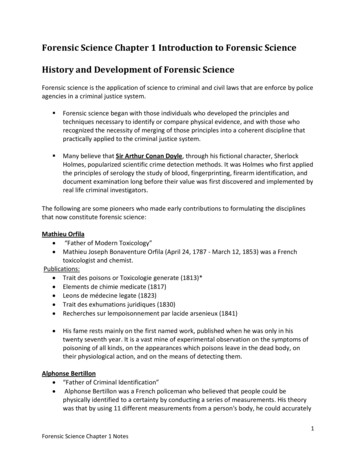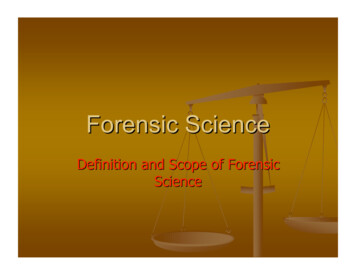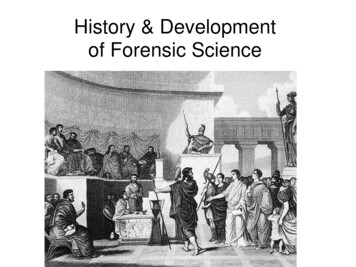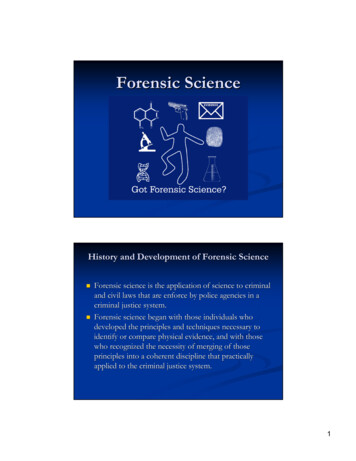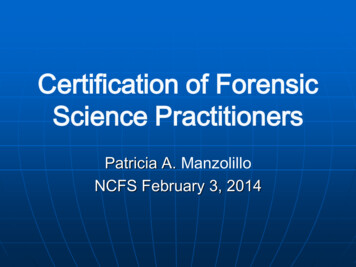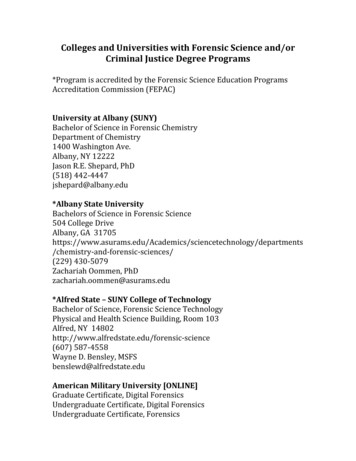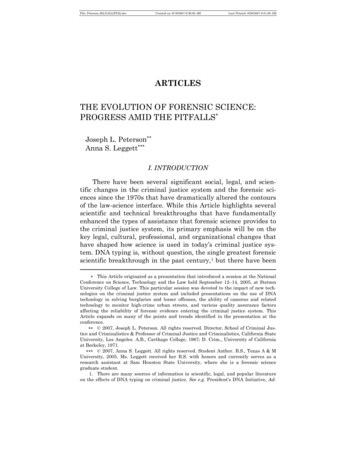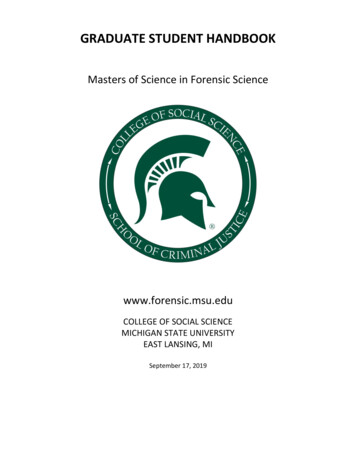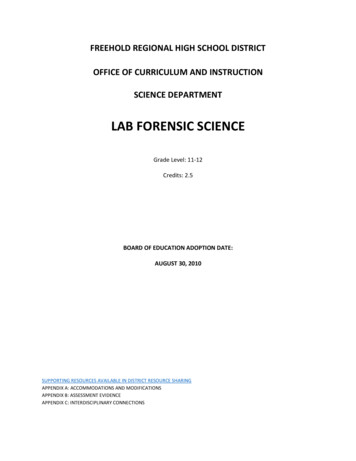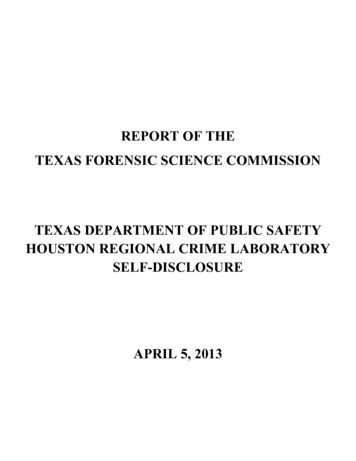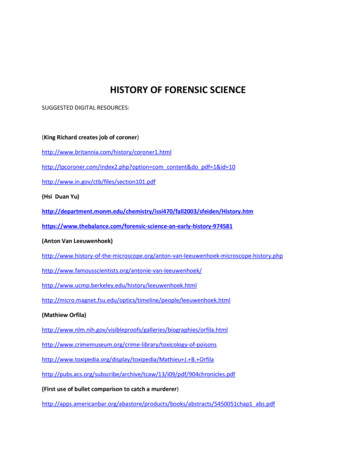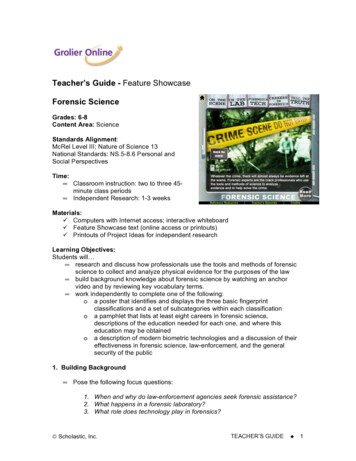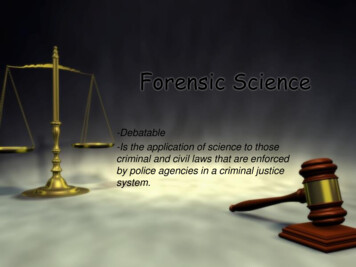
Transcription
Forensic Science-Debatable-Is the application of science to thosecriminal and civil laws that are enforcedby police agencies in a criminal justicesystem.
Important PeopleMathieu Orfila (1787-1853)-Father of forensic toxicology-Spanish-Taught medicine in France-1814-published a report on the detection of poisons and their effectson animals.Alphonse Bertillon (1853-1914)-Father of original identification.-Developed the science of anthropometry-a systematic procedure oftaking a series of body measurements as a means of distinguishing anindividual from another.-Replaced by fingerprinting.Francis Galton (1822-1911)-1st definite study of fingerprints and developed a methodology ofclassifying them for filing.-1892-Wrote book on fingerprinting.
Important People Cont.Leone Lattes (1887-1954)-Discovered the ABO blood typing-1915-Developed a procedure to determine blood group of dried blood.Calvin Goddard (1891-1955)-U.S. Army Colonel-Began the use of comparison microscope to match fired and test firedbullets from a gun--BallisticsAlbert S. Osborn (1858-1946)-Wrote questioned documents (1910)-Developed the fundamental principles of document examination which wasaccepted by the courts.
Important People Cont.Hans Gross (1847-1915)-Prosecutor and judge in Australia-Spent years developing and studying the principles behind a criminalinvestigation.-Incorporated fields of microscopy , chemistry, physics, minerology,zoology, botany, and fingerprinting.Edmond Locard (1877-1966)-French-Developed the “Locard’s Principle”“With every contact people have, they leave something behind.”
The Scientific Method and The CriminalInvestigationScientific Method1- State the problem2-Form a hypothesis3-Collect dataObserving andexperimenting4-Interpret the data5-If data supportshypothesis,collect more data6-Draw conclusionsCriminal Investigation-What crime was committed and in whatjurisdiction?-Hypothesize as to possible suspects basedon information gathered fromwitnesses, physical evidence at thecrime scene, and motive (if determined)-Seek out pertinent records-Review and evaluate the evidence so faravailable relative of making a case-foror against each suspect-Seek additional evidence that will helpsupport and prove your case-Arrest suspect and continue seekingevidence to support or refute the guiltof defendantThe answer is always there, it is just a matter of asking the right questions.
Crime ScenePhysical Evidence: Only and all objects that can establish that a crime has beencommitted or can provide a link between a crime and its victim or a crime andits perpetrator.Types of EvidenceTemporary-May bechanged orcan be lost.Conditional-Associatedwith specificconditions atthe crime scene.Associative-Links thesuspect orvictim to thescene.PatternTrace/Transfer-Blood-Produced by-Impressionsphysical contact-Tire treadswith some surface.-Residues thatshow the Modus Operandi(how it occurred)
Crime Scene Cont.Common Examples of Evidence-Bullets or Firearms-Fingerprints: visible or latent-Hair-Blood, Semen, Saliva-Footprints (impressions)-Documents-Drugs-Explosives-Petroleum Products-SerialNumbers-Fiber: Natural or Synthetic-Glass-Organs-Paint-Plastic Bags-Plastic, Rubber, or other polymers-Powder Residue (gun)-Soil and Minerals-Tool Markings-Vegetative (wood, plants, etc )
Crime Scene Cont. Class Evidence Individual Evidence-Evidence that possescharacteristics that canonly be associated with asgroup and never a singlesource.Ex) Blood Types-Evidence that can beassociated with acommon source withextremely high degree ofprobability
Processing The SceneSecure and Isolate the Crime Scene-1st officer on the scene-Goal is to preserve and protect to the greatest extent-Only allow authorized people in-Rope and barracadesRecord the Scene-Limited amount of time at the sceneonly one shot tofind everything.-Don’t want to touch anything.-Photograph the scenescale.-Sketch the scenerough and then final.-Take notes.
Processing The Scene Cont.Conduct a Systematic Search for Evidence-A search for physical evidence at a crime scene must be thorough andsystematic:SpiralStrip or LineGridsssQuadrant (Zone)
Processing The Scene Cont.Collect and Package Physical Evidence:-The integrity of the evidence is best maintained when the item is kept in its originalcondition.-Do this to prevent contamination, breakage, evaporation, accidental damage, or loss.-Each piece will have its own container/bag.Maintain Chain of Custody:-The documentation on the container that shows who is and where the evidence wentfrom the crime scene to the court house.Obtain Controls:-This is used to match evidence from the scene to an individual or known object.Submit Evidence to the Laboratory:-There are different laboratories under different jurisdictions. Depending on theinvestigators and type of crime depends where the evidence was sent.
Processing The Scene Cont.Henry Lee’s Linkage Principle:Crime SceneVictimEvidenceSuspect*You need to be able to argue the case between all four“Air Tight Case”Product Rule:-The probability of independent events.
Crime Scene Documentation-The documentation of a crime scene consists of photographshelpsdocument the facts and physical evidence at the crime scene.-The crime scene sketchused to plot accurate measurements made atthe scene.-Taking notesKeep a log that records time of discovery of thecrime.Fixed Point Method-Door-Window-Wall Corner-Permanent Object-Pick two fixed points-Draw a line from thepoint to the object.Bookshelf
Albert S. Osborn (1858-1946)-Wrote questioned documents (1910) -Developed the fundamental principles of document examination which was accepted by the courts. Important People Cont. Hans Gross (1847-1915)-Prosecutor and judge in Australia -Spent years developing and studying the principles behind a criminal investigation. -Incorporated fields of microscopy , chemistry, physics, minerology .
